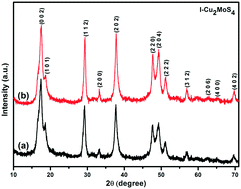Fabrication of Cu2MoS4 hollow nanotubes with rGO sheets for enhanced visible light photocatalytic performance
Abstract
Herein, ternary Cu2MoS4 hollow nanotubes were incorporated into reduced graphene oxide sheets (rGOs) via a facile hydrothermal route. A blue shift in the absorption edge of the Cu2MoS4/rGO photocatalyst was observed in comparison with that of Cu2MoS4 alone (without rGO), which confirmed the formation of interfacial contact between rGO sheets and Cu2MoS4 hollow nanotubes. Both SEM and TEM images of Cu2MoS4/rGO clearly revealed the formation of hollow nanotubes and uniform distribution of Cu2MoS4 on the surface of rGO. The chemical oxidation state of the elements present in the catalyst was ascertained by means of XPS spectra. The significant quenching of the photoluminescence (PL) intensity of the rGO supported photocatalyst strongly suggested a unidirectional flow of photogenerated charge carriers on the one dimensional Cu2MoS4 hollow nanotube combined with the rGO sheet, and thereby greatly suppressed the electron–hole pair recombination. Besides, the shorter decay time (<τ> = 2.5) observed in Cu2MoS4/rGO using time-resolved PL studies confirmed the effective separation of the charge carriers in the presence of rGO sheets. Cu2MoS4/rGO was demonstrated as a visible light driven photocatalyst for the degradation of methyl orange (MO) dye. A maximum photocatalytic degradation efficiency of ∼99% was achieved towards MO dye using the rGO supported Cu2MoS4 photocatalyst, while only 57% degradation was noted for the Cu2MoS4 photocatalyst, i.e. without an rGO support under identical experimental conditions. The enhancement in the photocatalytic performance of Cu2MoS4/rGO was mainly attributed to the high dye adsorption and excellent electronic properties of rGO sheets. In addition, the active sites associated on the surface as well as the edges of rGO sheets might be useful in the unfolding and uniform dispersion of the Cu2MoS4 hollow nanotubes over the rGO support without much aggregation. The effect of different parameters such as the amount of photocatalyst, the dye concentration and initial pH on the photocatalytic degradation of MO was also studied. Furthermore, the stability of the catalyst was tested by reusing the Cu2MoS4/rGO photocatalyst for five consecutive runs without any notable loss in photocatalytic activity.



 Please wait while we load your content...
Please wait while we load your content...